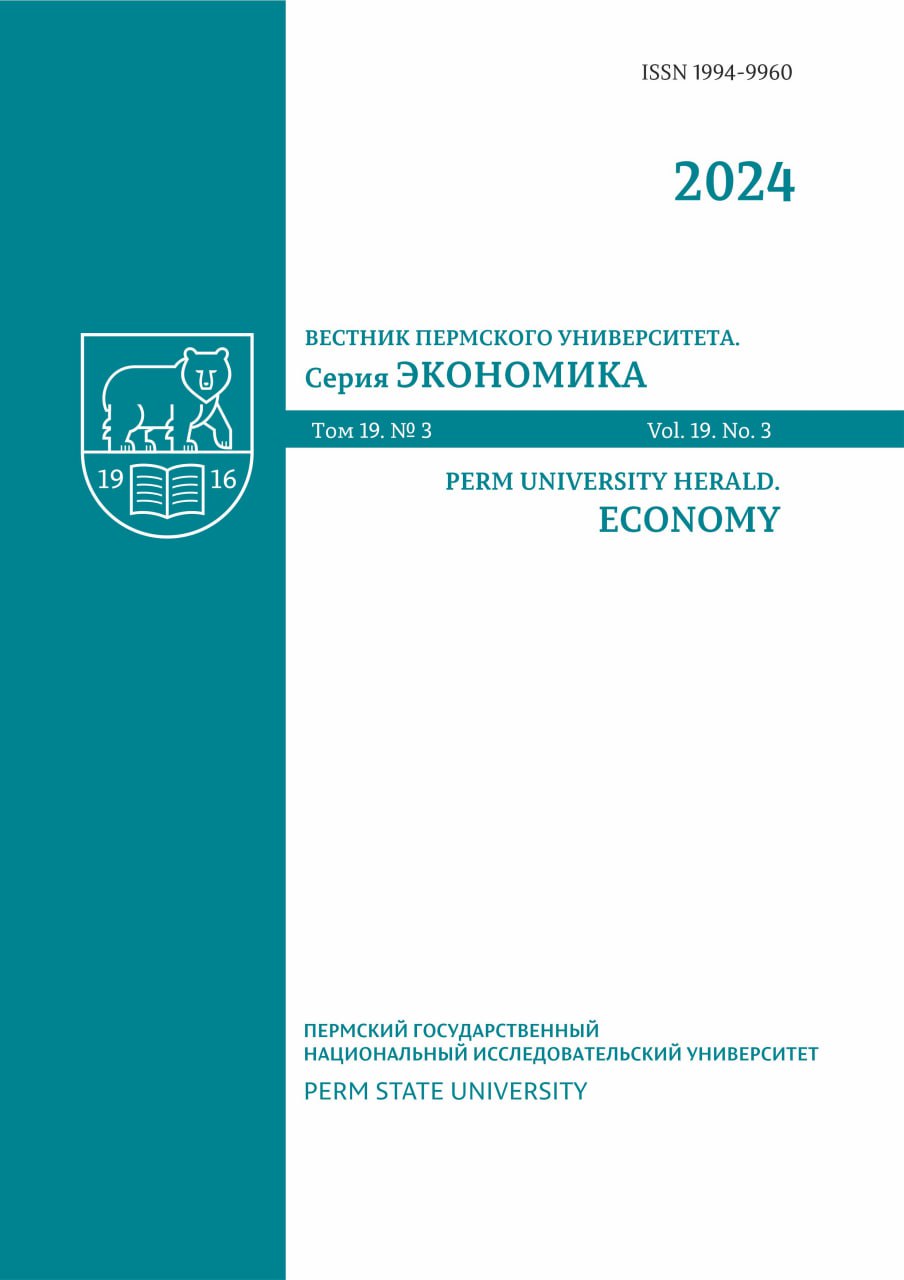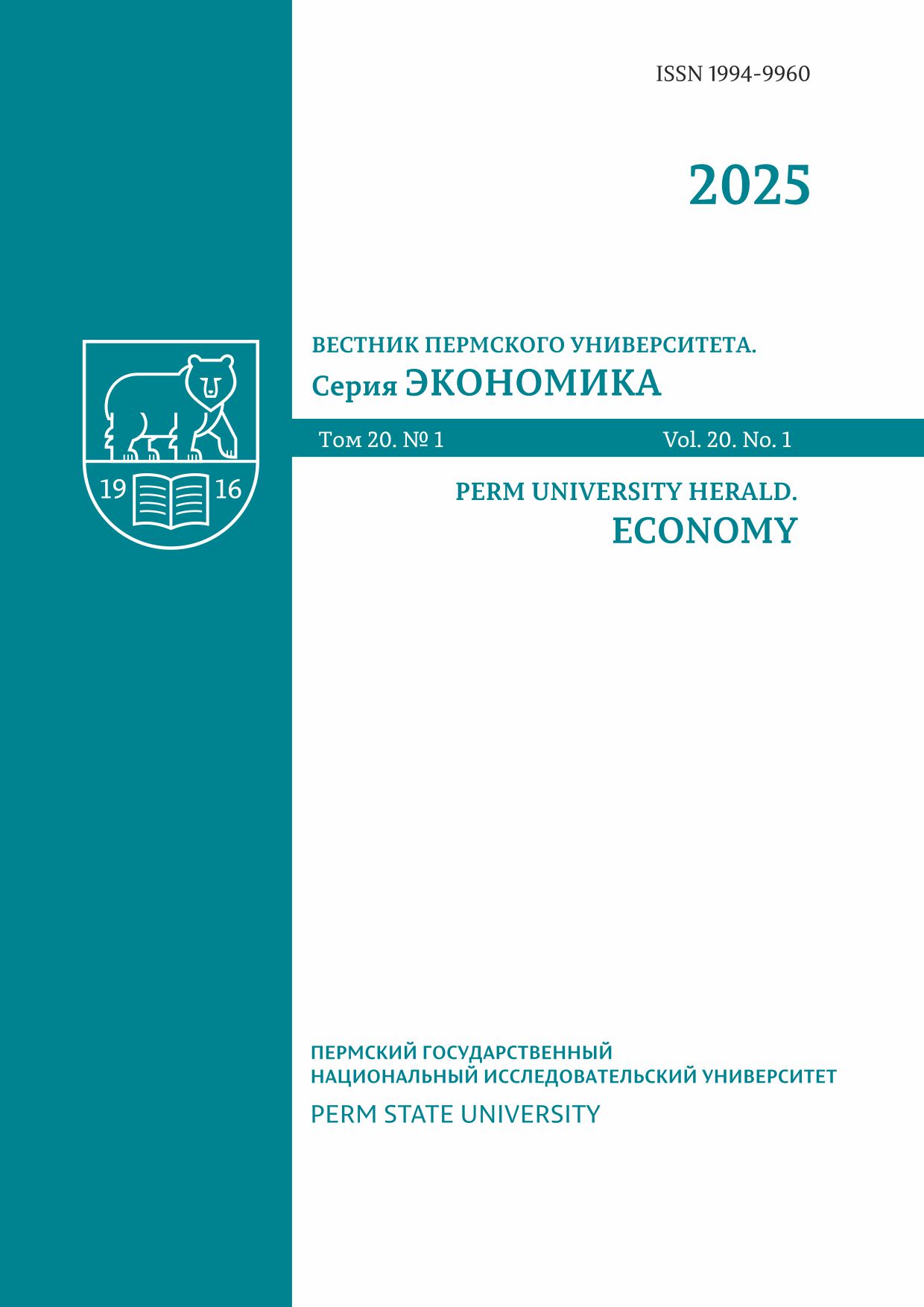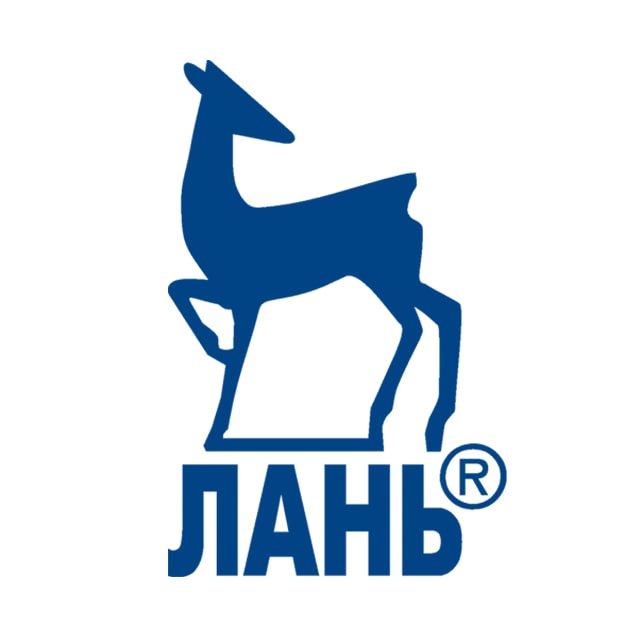Selection mechanism for regional energy security indicators
DOI:
https://doi.org/10.17072/1994-9960-2025-1-101-112Abstract
Introduction. Energy security issues are included in the agenda, which is determined by a crucial role of energy in economy and society. A specific methodology with a number of indicators could be applied to evaluate energy security. The methods developed so far can no longer provide an adequate picture of the security as they have become obsolete, increasingly biased, and currently unusable. Purpose. The study aims at developing a selection mechanism for indicators to evaluate the energy security of the region and prepare a list of these indicators. Materials and Methods. The work referred to such general scientific methods as analysis, synthesis, generalization, deduction, and systematization. An econometric modeling based selection mechanism is described. An indicator could be included in methodology if it influences economic security, given that energy security is an element of economic security and should ensure the achievement of its goals. The study used 2014–2022 data for 85 regions in the Russian Federation. Results. Literature overview revealed significant aspects of energy security, identified approaches to selection, and outlined the most common indicators used to evaluate the level of security. Correlation and regression analysis gave a list of 7 indicators that characterize the energy system, physical availability of resources, and environmental acceptability. Conclusions. The developed mechanism lowers the biased influence on the selection process, evaluates the validity of indicators, and excludes the insignificant ones. The study is intended for the government bodies in order to improve the evaluation of regional energy security and develop more efficient measures. Further research is supposed to expand the list of indicators by taking into account the aspect of affordability and various types of resources and develop the mechanism by including other economic security goals.
Keywords: energy security, indicators, energy industry, region
For citation
Osadchenko E. A., Ferova I. S. Selection mechanism for regional energy security indicators. Perm University Herald. Economy, 2025, vol. 20, no. 1, pp. 101–112. DOI 10.17072/1994-9960-2025-1-101-112. EDN TAALLJ.
References
- Voropai N. I. Energeticheskaya bezopasnost'. Terminy i opredeleniya. Moscow, Energiya Publ., 2005. 60 p. (In Russ.). EDN SDTFFJ
- Osadchenko Е. А. Methodological approaches to energy security assessment: Russian and foreign experience. Current Issues of Economy and Sociology: Book of Papers from 20th Fall Conference of Young Scientists in Akademgorodok (Novosibirsk, 10–11 October 2024). Novosibirsk, IEIE SB RAS, 2024, pp. 89–92. (In Russ.). EDN OKGVWH
- Tatarkin А. I. Modelirovanie sostoyaniya i prognozirovanie razvitiya regional'nykh ekonomicheskikh i energeticheskikh sistem. Moscow, Ekonomika Publ., 2004. 462 p. (In Russ.).
- Rabchuk V. I. Energeticheskaya bezopasnost' Rossii: problemy i puti resheniya. Novosibirsk, SB RAS Publ., 2011. 197 p. (In ). EDN QUWVIR
- Lapaev D. N., Sosnina E. N., Mityakov E. S., Nikonov A. N. Diagnostika energeticheskoi bezopasnosti regionov Rossii (na primere PFO). Bulletin of Belgorod State Technological University named after. V. G. Shukhov, 2014, 1, pp. 105–109. (In Russ.). EDN RTRYCZ
- Esfahani A. N., Moghaddam N. B., Maleki A., Nazemi A. The knowledge map of energy security. Energy Reports, 2021, vol. 7, pp. 3570–3589. DOI 10.1016/j.egyr.2021.06.001. EDN DNPRFV
- Huang Y., Zheng Z. Research hotspots and trend analysis of energy security based on citespace knowledge graph. Chemistry and Technology of Fuels and Oils, 2023, vol. 59, iss. 5, pp. 1024–1033. DOI 10.1007/s10553-023-01614-5
- Sovacool B. K., Mukherjee I. Conceptualizing and measuring energy security: A synthesized approach. Energy, 2011, vol. 36, iss. 8, pp. 5343–5355. DOI 10.1016/j.energy.2011.06.043
- Ang B. W., Choong W. L., Ng T. S. Energy security: Definitions, dimensions and indexes. Renewable and Sustainable Energy Reviews, 2015, vol. 42, pp. 1077–1093. DOI 10.1016/j.rser.2014.10.064
- Azzuni A., Breyer C. Definitions and dimensions of energy security: A literature review. Wiley Interdisciplinary Reviews: Energy and Environment, 2018, vol. 7, iss. 1, Article 268. DOI 10.1002/wene.268
- Strojny J., Krakowiak-Bal A., Knaga J., Kacorzyk P. Energy security: A conceptual overview. Energies, 2023, vol. 16, iss. 13, Article 5042. DOI 10.3390/en16135042
- Senderov S. М., Rabchuk V. I. Energy security today and the main methodological aspects of its provision. Energy Policy, 2022, no. 11, pp. 56–69. (In Russ.). DOI 10.46920/2409-5516_2022_11177_56. EDN ENQJIL
- Siksnelyte-Butkiene I., Streimikiene D., Lekavicius V., Balezentis T. Comprehensive analysis of energy security indicators and measurement of their integrity. Technological Forecasting and Social Change, 2024, vol. 200, Article 123167. DOI 10.1016/j.techfore.2023.123167
- Stavytskyy A., Kharlamova G., Komendant O., Andrzejczak J., Nakonieczny J. Methodology for calculating the energy security index of the state: Taking into account modern megatrends. Energies, 2021, vol. 14, iss. 12, Article 3621. DOI 10.3390/en14123621. EDN PORBPS
- Wu T.-H., Chung Y.-F., Huang S.-W. Evaluating global energy security performances using an integrated PCA/DEA-AR technique. Sustainable Energy Technologies and Assessments, 2021, vol. 45, Article 101041. DOI 10.1016/j.seta.2021.101041
- Amin S. B., Chang Y., Khan F., Taghizadeh-Hesary F. Energy security and sustainable energy policy in Bangladesh: From the lens of 4As framework. Energy Policy, 2022, vol. 161, Article 112719. DOI 10.1016/j.enpol.2021.112719
- Brodny J., Tutak M. The comparative assessment of sustainable energy security in the Visegrad countries. A 10-year perspective. Journal of Cleaner Production, 2021, vol. 317, Article 128427. DOI 10.1016/j.jclepro.2021.128427
- Zhang L., Yu J., Sovacool B. K., Ren J. Measuring energy security performance within China: Toward an inter-provincial prospective. Energy, 2017, vol. 125, pp. 825–836. DOI 10.1016/j.energy.2016.12.030
- Panasyuk V. Indicative method for assessing the energy security of the regions of the Republic of Belarus. Information and Mathematical Technologies in Science and Management, 2023, no. 3 (31), pp. 60–73. (In Russ.). EDN UFFXHG
- Abdullah F. B., Iqbal R., Ahmad S., El-Affendi M. A., Kumar P. Optimization of multidimensional energy security: An index based assessment. Energies, 2022, vol. 15, iss. 11, Article 3929. DOI 10.3390/en15113929
- Le T.-H., Chang Y., Taghizadeh-Hesary F., Yoshino N. Energy insecurity in Asia: A multi-dimensional analysis. Economic Modelling, 2019, vol. 83, pp. 84–95. DOI 10.1016/j.econmod.2019.09.036
- Tulupov А. S. National Security Assessment for the Russian Federation. Lomonosov Economics Journal, 2024, vol. 59, no. 4, pp. 3–23. (In Russ.). DOI 10.55959/MSU0130-0105-6-59-4-1. EDN XMIVNI
- Kononov Yu. D. Goals and methods of estimating energy security indicator thresholds in forecasts. Problemy prognozirovaniya, 2024, no. 1 (202), pp. 105–115. (In Russ.). DOI 10.47711/0868-6351-202-105-115. EDN PFBBUK
- Huang S.-W., Chung Y.-F., Wu T.-H. Analyzing the relationship between energy security performance and decoupling of economic growth from CO2 emissions for OECD countries. Renewable and Sustainable Energy Reviews, 2021, vol. 152, Article 111633. DOI 10.1016/j.rser.2021.111633
- Tutak M., Brodny J. Analysis of the level of energy security in the three seas initiative countries. Applied Energy, 2022, vol. 311, Article 118649. DOI 10.1016/j.apenergy.2022.118649
- Brodny J., Tutak M. Assessing the energy security of European Union countries from two perspectives – A new integrated approach based on MCDM methods. Applied Energy, 2023, vol. 347, Article 121443. DOI 10.1016/j.apenergy.2023.121443
- Osadchenko Е. А. Place of energy security in the security system of the Russian Federation. Herald of Omsk University. Series “Economics”, 2024, vol. 22, no. 3, pp. 83–91. (In Russ.). DOI 10.24147/1812-3988.2024.22(3).83-91. EDN GFFCRN











